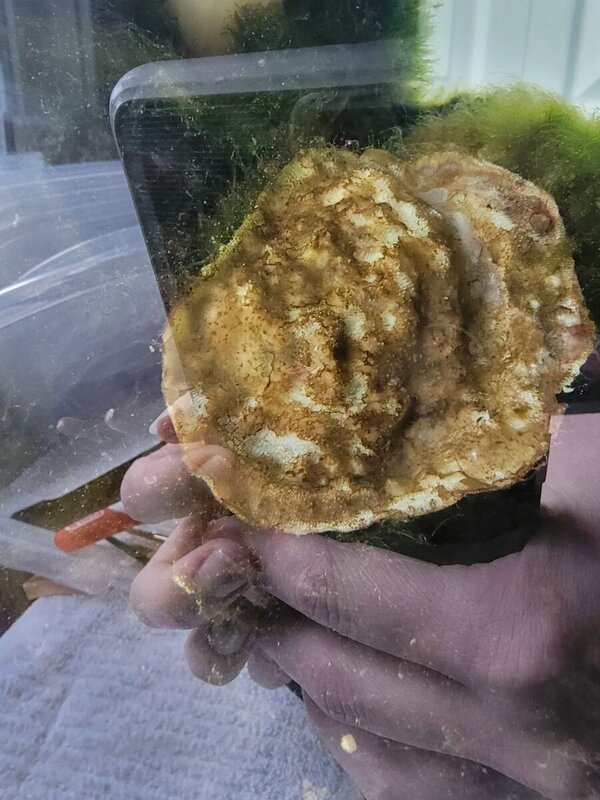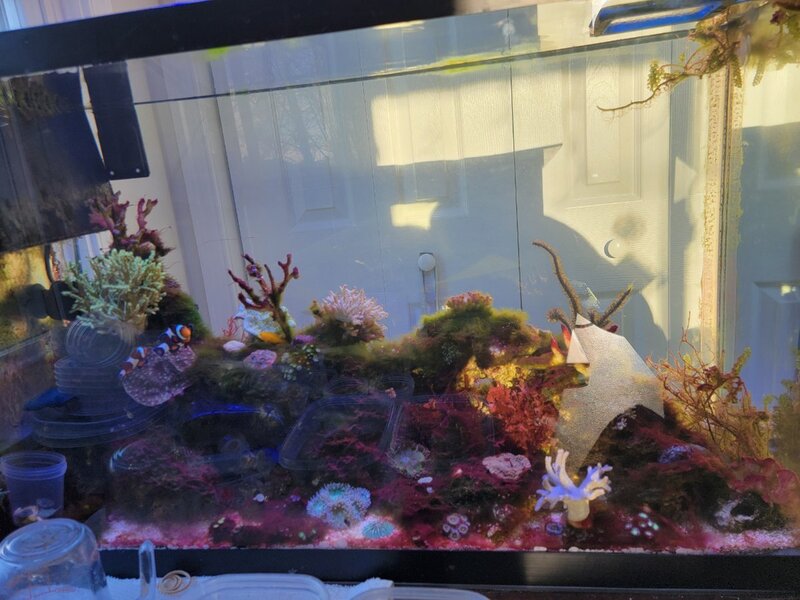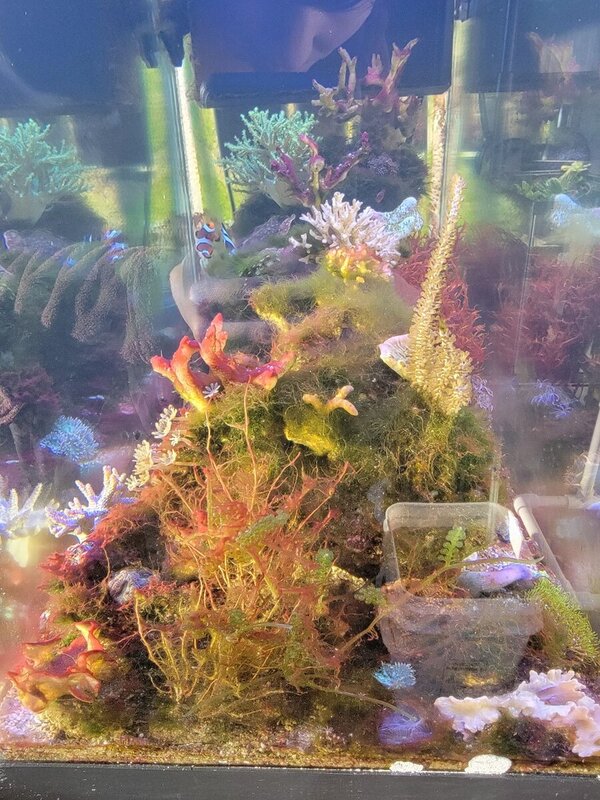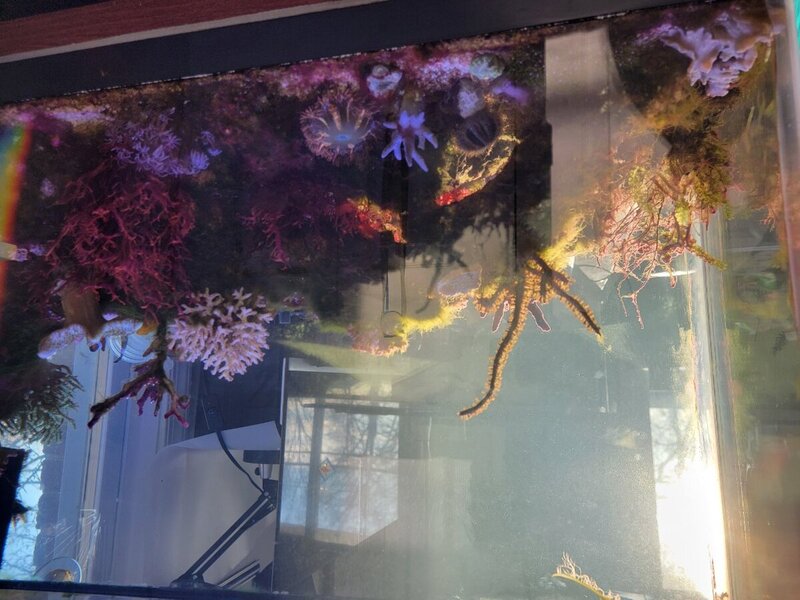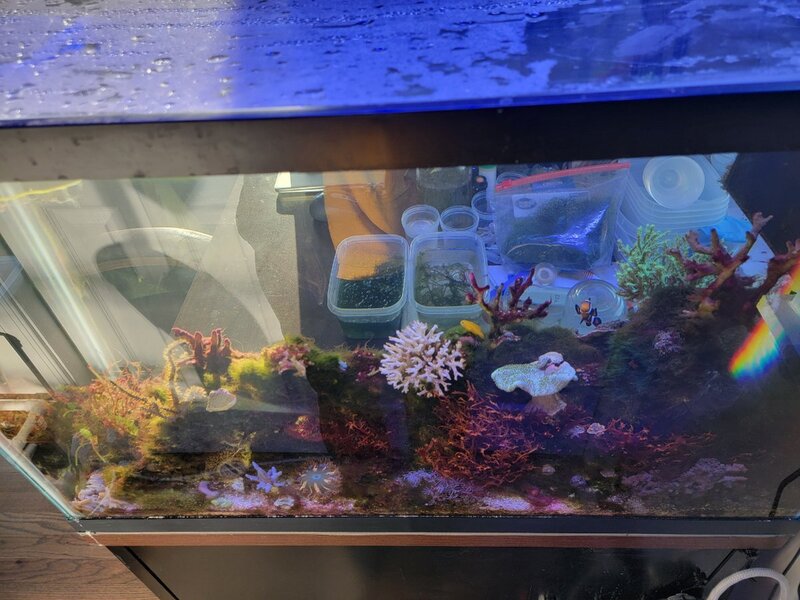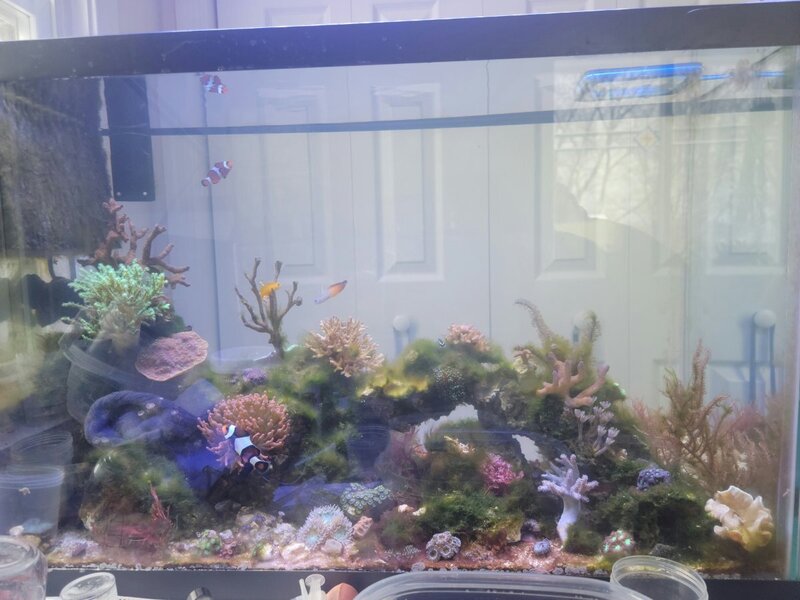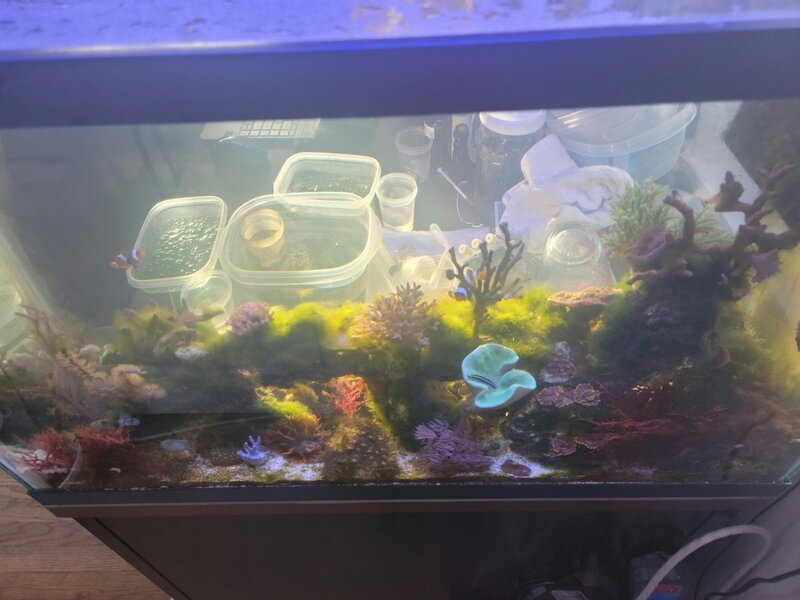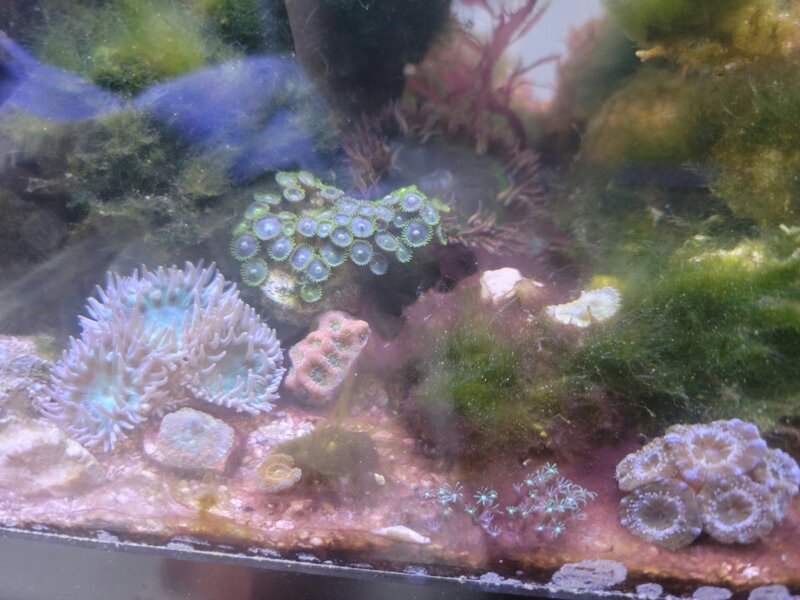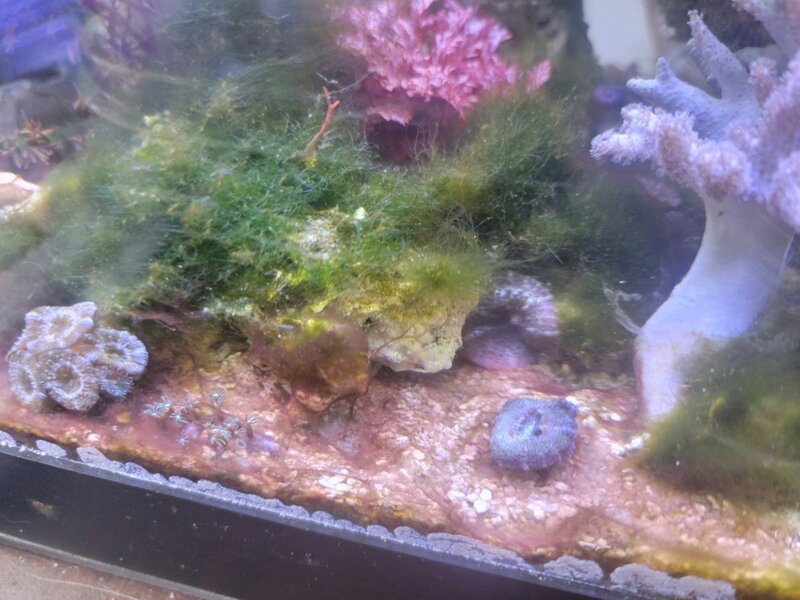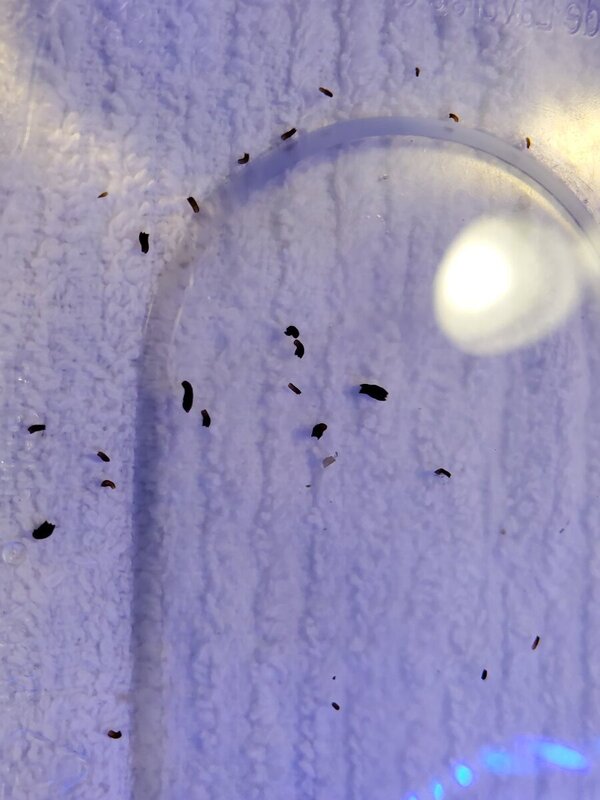
Kathryn Lawson
WAMAS Member-
Posts
200 -
Joined
-
Last visited
Content Type
Profiles
Forums
Gallery
Events
Store
Everything posted by Kathryn Lawson
-
Need advice - algae and cyno; nitrate 0, phosphate 0.3
Kathryn Lawson replied to Kathryn Lawson's topic in General Discussion
The main reason I'm considering IO over RC is that RC has more elevated alk, calc, and mag. I've read a number of forum posts with people commenting that they prefer IO because they don't have to worry as much about alk etc. swings when doing water changes like they experienced with RC. Yes, my skimmer has been on and skimming very wet - I've been dumping it when doing the daily water change. I wasn't able to measure phos every day last week - the measurements I have are 0.48 on 2/23 (at the end of the blackout, before starting daily water changes), 0.37 on 2/28, and 0.31 on 3/3. (Nitrate levels for those dates were 16.7, 12.4, and 10.8, respectively). So definitely heading in the right direction, at least! I just hope my struggling corals can hold out long enough to get nutrients balanced and cyano controlled -
Need advice - algae and cyno; nitrate 0, phosphate 0.3
Kathryn Lawson replied to Kathryn Lawson's topic in General Discussion
The salt I've been using is Crystal Sea Marinemix, Bioassay formula. Mixes up as Nitrate 0 Phosphate 0.02 (was from RODI, but replaced filters last night so should be addressed now) Alk 10.0 Calcium 388 Mag 940 It looks like this salt is low in calcium and magnesium compared to what is desirable. Since I've been using this salt for a year now, I'm not inclined to think this is the direct cause of the sudden/major issues I've been dealing with, though it is quite probably an underlying factor destabilizing coral health. I'm thinking I'll use up my current salt with these daily water changes, then once those are done (or sooner if I run out of salt), switch (probably more slowly than with daily changes, to avoid shock?) to a different salt - perhaps regular Instant Ocean (not reef crystals). Does this sound good, or should I consider an alternative salt or doing the switch during the daily changes? An ICP test isn't a bad idea. Any recommendations for brand, likely prioritizing response time? I'm also wondering about careful use of a phosphate reducer to help balance my nutrients slightly faster than water changes/biological growth can do alone, now that nitrates are right around where we want them. Thoughts? -
Need advice - algae and cyno; nitrate 0, phosphate 0.3
Kathryn Lawson replied to Kathryn Lawson's topic in General Discussion
Hi all. After a bit over a week of daily water changes (3 gallons a day on my 29+maybe 6 gallon system), my parameters are: Nitrate 10.8 Phosphate 0.31 Alk 10.8 Calc 389 Mag 980 Cyano is still super thriving and corals are still looking pretty unhappy (as is my bubbletip nem, which is super shrunken to the point of almost being unrecognizable, and moving around). Even my softies are looking bad - among other things, some mushrooms have had their mesenterial filaments spilling out their mouths pretty much all the time, and a Kenya tree looks like part of it is dissolving into goo. Some of the corals that had been seemingly stable during the previous weeks have had cyano on them this past week and are now showing tissue loss/recession, so I'm getting pretty worried about the cyano, which I think is probably my main issue right now (I know my water parameters aren't great, but they also don't seem bad enough to match the impact I'm seeing on my corals). I have heard some pretty good things about using coral snow (calcium carbonate) as a flocculent and to help against cyano, though it seems to be more recommended for prevention or light cases of cyano (which mine certainly isn't - the whole tank was covered in red before I siphoned it for multiple hours yesterday). Anyone have experience using coral snow for bigger cyano problems? Besides considering coral snow, I'm feeling pretty close to pulling the trigger on using chemiclean, with the plan to siphon out the cyano I can beforehand, remove carbon, remove the skimmer cup, and add air stones in the tank during dosing. Anything else I should be aware of/do? Oh, the one bit of good news is that my fish are fully switched over to pellets now - I moved up a size with TDO, and the current pellets seem to have a pretty good floating/slow sinking rate. I've been finally seeing every fish eating every feeding, which is a relief! As always, thanks for your feedback! -
Need advice - algae and cyno; nitrate 0, phosphate 0.3
Kathryn Lawson replied to Kathryn Lawson's topic in General Discussion
I should have clarified, the phosphate is coming from my source water (results a few posts back). I have new filters on the way! However, I think it's probably a pretty minor contributor of overall phosphate in my tank, compared to the food. -
Need advice - algae and cyno; nitrate 0, phosphate 0.3
Kathryn Lawson replied to Kathryn Lawson's topic in General Discussion
Thank you all for the input! I did an initial 20% water change on Saturday and have been doing daily 10% water changes since then. Skimmer is on constantly and skimming wet, and I added a filter sock to the flow coming into my sump. I stopped dosing nitrate/vinegar/Microbacter7. Carbon is still in though, since the disintegrating spot on the one leather is still there, though the rest of the leather is finally showing a bit of polyp extension again. The other surviving corals have been looking a bit better also, though cyano has been coming back in full force. I've been working on convincing my fish to eat pellets. My smallest fish have struggled to fit New Life Spectrum Thera+A pellets into their mouths, and the pellets sink pretty immediately so most end up falling to the bottom (far more uneaten mass than with flakes, so I wonder if at least for now, switching to pellets may result in higher water nutrient levels). I tried some much smaller pellets also, Reef Nutrition's TDO ChromaBoost. These granules seem to stay floating longer in the feeding ring and fall more slowly so the fish have more time to realize they're there, though I'm not sure that these tiny pellets are really much different from pieces of flakes. Hopefully over time my fish will learn to eat the pellets faster, or figure out that they can eat fallen food from the rocks/sand! I might try some pellets in an auger-based autofeeder (supposedly more precise than rotating ones), maybe using super tiny amounts more frequently, since right now my firefish hide as soon as I move the tank lid to put pellets in, and by the time they come back out most of the food is gone/fallen. My water parameters are as follows: 2/28 reef tank Nitrate 12.4 Phosphate 0.37 Alk 11.2 Calcium 388 Mag 980 (slightly higher than fresh salt water, maybe due to slight test/water variability?) Fresh salt water Nitrate 0 Phosphate 0.02 Alk 10.0 Calcium 388 Mag 940 It looks like my fresh salt water is a bit high in alk and low in calcium and magnesium compared to what is desirable. I guess either I could make dosing calc/mag a standard practice or change salt brands, but am leaning towards a brand change for simplicity. I'm thinking I'll work on using up my current salt with these daily water changes, then once those are done, switch (more slowly) to a different salt - perhaps regular Instant Ocean (not reef crystals). Does this sound good, or should I consider an alternative salt or doing the switch during the daily changes? I'm guessing I should keep up the water changes and testing. Not sure if I should consider Chemiclean or H2O2 for the cyano, or hold off for now - thoughts? -
My Third Coral-Related Hobby: Fossils!!
Kathryn Lawson replied to ReefdUp's topic in General Discussion
These are super fascinating, as well as gorgeous!!! Thanks for sharing! -
Need advice - algae and cyno; nitrate 0, phosphate 0.3
Kathryn Lawson replied to Kathryn Lawson's topic in General Discussion
Going back to basics makes sense. The salt I've been using is Crystal Sea Marinemix, Bioassay formula - a friend's workplace uses it in bulk and I can buy a bag from them pretty cheaply. They don't have corals but do have an oyster reef, and in doing some Internet research I found that it has been used in the past for corals, invert spawning projects, etc. Would you consider this a good *reef* salt? TDS is 0, but I'll order new filters today. I've changed out the DI resin since I got it (when it changed color), but not the other filters, which in hindsight I probably should have done then to be safe, but at the time money was pretty tight. I'll also get another filter sock, or maybe two... Daily water changes will be a huge pain, and I'm not certain I'll be able to keep up with it and testing everything daily, but I'll give it a shot, prioritizing the water changes over daily testing if necessary. I'll also try to get my fish over to pellets and/or frozen food. Oh, and yeah, it completely makes sense that I need to have my skimmer on to remove bacteria! I'd had it off to try to get nitrates above 0 to fight cyano, but I'm definitely there for now (and the cyano is still here anyway). I'll turn it back on, maybe starting with a few hours a day? -
Need advice - algae and cyno; nitrate 0, phosphate 0.3
Kathryn Lawson replied to Kathryn Lawson's topic in General Discussion
So I just ran some more tests and it looks like @ReefdUp is on to something with questions about my mag and calcium levels. I'll look into products for dosing these without further raising alk - any recommendations? It also looks like a bit of phosphate might be sneaking past my RODI @cpeguero, so I should probably swap out the filters (though I would imagine the amount of phosphate in the flakes I'm feeding would outweigh this relatively small amount). Reef Tank Water Ammonia 0 Salinity 1.026 (checked/calibrated with RODI) Calcium 387 ppm Mag 940 ppm Nitrate 16.7 Phosphate 0.48 Alkalinity 12.2 Temp controlled by Inkbird, 76-78F RODI Nitrate 0 Phosphate 0.03 Alk 0.7 Chloramine, free ammonia (test step) 0 @ranger I know ozone used in large-scale wastewater treatment and some bigger tanks, but I thought it was generally a pretty big investment and required careful monitoring due to the associated health risks. I have parrots which have extremely sensitive respiratory systems, so I don't think ozone would be a good choice for me. As I understand it, the main benefits of ozone are disinfection and oxidation, which can also be done with H2O2 dosing or UV. I could see this being especially useful to kill cyano cells in the water column and limit its spread. I've seen reports of folks fighting cyano with these methods - now I'm wondering what might be least harmful to the rest of my reef. In other news, I'd forgotten to mention that when I'd siphoned out the cyano before the blackout, I discovered one of my leathers was extremely unhappy about cyano on it - part of the flesh underneath was disintegrating. So I added about a double handful of carbon in a filter bag in my sump before the blackout, to help with any chemicals it might be producing. Post blackout, it still looks pretty unhappy but also seems to have shed, so that might be partially why it's so shrunken now. I don't usually run carbon though. Right now I'm still feeding Prime Reef flakes daily, though less than before. A few of my fish don't seem to recognize frozen food or pellets as being food, but I really should work on that... I'm dosing ~15mL (2 caps) of Microbacter7 per day, and 15mL (2 caps of vinegar) per day, though in the last few days I've started adding some extra vinegar (3 caps total). The kalk reactor is entirely unplugged, and so is my skimmer. I don't usually have mechanical filtration in place, except when I'm siphoning algae (and I seem to have misplaced that filter sock... gonna have to get another one!) -
Need advice - algae and cyno; nitrate 0, phosphate 0.3
Kathryn Lawson replied to Kathryn Lawson's topic in General Discussion
Thanks for the feedback! I'm leaning more and more towards using chemiclean for the cyano, but I'm not sure that's the only problem I'm dealing with. (I had one money cowrie but it died right around the same time as the snails and urchin died). I just finished a three day blackout (meant to eradicate the cyano) after extensive siphoning of cyano and algae. Unfortunately I still see cyano, and while I expected nitrates and phosphates to rise some due to the blackout, I'm now at 16.7ppm nirate and 0.48ppm phosphate. (I've continued dosing Microbacter7 and vinegar). Oddly, my alkalinity is even higher than before - 12.2! I'm really getting concerned about this now, both in terms of why it's rising, as well as how to reduce it... Any thoughts/advice? Also, during the blackout, my piece of Hollywood Stunner chalice went from being pretty stable to seemingly having completely died off - the skin seems to have disintegrated almost. I'll post a pic below. It seems unlikely that this would be just due to the blackout, but maybe the combination with high alk? -
Need advice - algae and cyno; nitrate 0, phosphate 0.3
Kathryn Lawson replied to Kathryn Lawson's topic in General Discussion
Hi all, more updates but unfortunately things are still not great. After my last post, I did do a ~50% water change. However, with additional deaths around the same time (the last of the 5 snails I added died, along with the urchin and I think my pompom crab - I don't think what I pulled out was just a molt), by the time I measured my nutrients again a day or so after the water change, I was back to the same nutrient levels as I'd started. No livestock health seemed to improve with the major water change so I'm probably not dealing with heavy metals, etc., though I'm still considering an ICP test to confirm. I've continued losing corals, mostly SPS but my LPS and softies are clearly also unhappy (and the gorgs that the skin fell off are pretty definitively dead). I've pretty much lost all branching SPS entirely at this point, except the poccillipora that I've had the longest, and that one has gone dramatically downhill over the last week or so with tissue peeling off, so I'm not expecting it to live much longer either. I've been dosing Microbacter7 (as directed on the bottle, 2 caps per day) and vinegar for over a week now (started with one cap per day and now up to two - I've been lazy about measuring it more exactly, but can figure out the dose in mL if relevant), along with the nitrogen as needed to maintain nitrate levels. Phosphates have dropped to 0.2, with nitrates at 3.4. Despite having turned my kalk reactor pump off weeks ago, alk has oddly continued to rise - at 11.5 now, which I'm getting concerned about. I just physically unplugged the kalk pump just in case the timer controlling it malfunctioned somehow. Cyano is still running rampant, worse than ever before, and I'm wondering if it's harming more than just corals at this point. My bubble tip nem has been shrunken and looking unhappy for multiple days now, and yesterday I noticed that it actually moved out of its chosen little crevice and went underneath a rock - it hasn't moved at all since it found that spot when I put it in a year ago, so I'm taking this as a sign that something in the tank is still very wrong (my 2 rock flower nems are looking fine for now, thankfully). I added some activated carbon a few days ago to hopefully absorb any toxins from the cyano, but haven't noticed any improvement yet. I added some grape caulerpa 2-ish weeks ago, and while it has grown some, most of the pieces have at least some cyano covering them. I picked up some chaeto at the meeting last week (thanks to whoever brought it for free!) but haven't yet added it, since I think it's just going to get coated with cyano and/or hair algae (and I figured I should quarantine/observe it for a bit before adding to my system). Any thoughts as to what I should do, other than keep (endlessly, it seems) siphoning out cyano? I'm tempted to try a 3-day blackout to try to knock back the cyano, but also am afraid that it might really hurt the corals that are already struggling. I do have chemiclean, but want to avoid using it casually (likely only as a last resort). -
Reef eScape does, and I think there are some individuals around here that do also
-
Need advice - algae and cyno; nitrate 0, phosphate 0.3
Kathryn Lawson replied to Kathryn Lawson's topic in General Discussion
Hey folks, just wanted to provide an update, though the news isn't great. I've been dosing nitrogen and had gotten to around 5 ppm, then a slightly increased dose and the deaths of two new snails brought me to 9.5 ppm as measured tonight. Phosphate are essentially the same at 0.31. Alk is 10.5, which is high for me, and I've temporarily stopped dosing kalk. The hair algae has slowed down in terms of growth, which is interesting since I've been increasing nitrates and expected the opposite. The cyano is unfortunately worse than when I first posted, in both thickness and spread, and there's two types now. I'd seen this second type before but it had seemed to go away for a bit. This type of cyano seems to appear randomly on previously healthy coral tissue, and seems to be actively harming them, particularly SPS - even if I siphon it off the same day I first see it on a spot, the coral underneath is bleached and the tissue receded in that spot. More concerningly, I have several corals including two poccillipora that have been dying back from the base, and at this point only a bit of flesh send to be left on the branch tips. One of these had struggled in the past but stabilized and I thought was beginning to recover, before taking a dramatic downtown in health this past week along with a third pocci that is bleaching spottily all over. I was siphoning out algae tonight and noticed much of the remaining tissue of the first two is very loosely attached. Adding to my alarm, two of my three gorgonians have completely bleached over the last few days and the skin just crumbled off leaving just the skeleton behind tonight when I tried to lightly siphon off some hair algae that had been caught on the branches (these same gorgs had held up really well to being siphon-cleaned previously, usually looking far better the next day). These two apparently dead gorgonians were pretty thin and were of the same type, as opposed to my remaining gorg which is a different type with thicker branches and seems to be ok for now (but not looking quite normal, polyps were in). I tried to add 3 trochus snails and two turbo snails from a local shop this week. I specifically selected ones that were actively moving around their tanks and climbing the rocks/glass. Two of them are now dead (one trochus, one turbo) and I've noticed that the remaining ones don't seem to be able to stick onto any surface. It's odd, they are actively coming out of their shells and seem to be trying to move around but just don't grip on to anything (I've tried placing them on a few different locations and surface types now). I had this issue with the turbo I tried to add a few months ago, also. On top of all this, one of my urchins hasn't been moving around much and today I realized it was completely upside down on the sand next to a rock, but moving slightly. I righted it and set it on a flat rock, and will keep an eye on it. My fish all seem completely normal, thankfully. With the recent dramatic downturns in coral and CUC health, I'm wondering if I should try to do a fairly large water change there's some contaminant in the water that I'm not measuring. This would certainly help dilute the phosphates, but will also drop the nitrates that I've been working to raise. Any thoughts on whether this might be a good idea? Anything else I should do/measure? -
Need advice - algae and cyno; nitrate 0, phosphate 0.3
Kathryn Lawson replied to Kathryn Lawson's topic in General Discussion
Thank you all!! It really does sound like dosing nitrate should be my next step (and Vibrant is definitely tabled for the current scenario - I hadn't read about any long-term effects on macroalgae, so thanks for the heads up!). I'm really glad to hear that my corals and bacteria should take up the nitrogen before the algae - that was my main concern with dosing N to balance out P. I looked into some options and then realized I actually already have Seachem Flourish Nitrogen (acquired from a freshwater hobbyist when adopting some fish in need of homes), which is a mix of potassium nitrate and urea (providing ammonium). Any suggestions on how slow/fast I should try to raise nitrate levels? I'll need to be pretty careful with the Seachem product, as I can only expect an immediate nitrate test to show half of the nitrogen I'm dosing (since the other half will be ammonium). Seachem says the product is 15,000 mg N/L, for reference. I actually have been culturing phyto and copepods, but should probably dose far more regularly! I've been curious about trying a semi-continuous culture/dosing setup next to my sump. Maybe I'll try to set that up this weekend. RE flakes, I'm using Ocean Nutrition's Prime Reef Flakes, which I thought was one of the better options - thoughts? I'd tried pellets but they seemed to sink way too fast for my fish to eat the majority of them. I do feed frozen sometimes, but my fish oddly seem to prefer the flakes (and I have to say, I do too, though I'm not opposed to feeding frozen). I use a feeding ring so they don't go down my overflow. My sump light is a well-rated but budget Amazon light. It was my main light for my 10 gallon tank for 6 months, and corals seemed to do really well with it. I have it on a reverse cycle compared to the display tank light. RE alkalinity, I'd seen some discussion of higher alk inhibiting cyano also. And my alk is still kinda low despite starting to slowly dose kalk a few weeks ago (kalk stirrer on a timer), so I'm going to continue to slowly increase my dosage and monitor. I forgot to mention, I do have a powerhead, running along one side of the rockwork peninsula. The sump return goes along the other side of the rockwork in the same direction. I already adjusted my sump return nozzle to direct more flow at the area that keeps getting cyano, but haven't noticed a difference. Oh, and I'm using RO/DI water I make myself. Last I checked the TDS was either 0 or very close, but I'll check again to make sure it's still looking good -
Need advice - algae and cyno; nitrate 0, phosphate 0.3
Kathryn Lawson replied to Kathryn Lawson's topic in General Discussion
-
I've been struggling with algae and cyanobacteria in my 30 gallon tank, which has been up and running for almost exactly a year now (had a smaller tank for 6 months previous to that, and started with live rock). Right now, my nitrate concentration is 0 ppm (too low), and phosphate is 0.3 ppm which I understand is higher than "ideal". My nitrate to phosphate ratio being messed up is probably why I have some cyano on top of the turf and hair algae, since cyano can fix atmospheric nitrogen and thus grow in nitrate-limited environments. The turf algae has been a long-term but seemingly-reasonably-paced fight, but the cyano and hair algae are relatively new (last 2-3ish months) and seem to really be throwing my system out of whack. I know from a coral growth perspective that nitrates at 0 isn't great, and also gets me into the danger zone for dinos. This leads me to think that I might be better off starting to dose nitrogen rather than trying to reduce phosphate with GFO or other removal method. The only thing is, that will likely further fuel my algae outbreak. I'm already spending multiple hours a week siphoning out hair algae to keep my corals from being overgrown/outcompeted, which is pretty much my limit in terms of time/effort I can dedicate to algae removal. Snails don't seem to be helping much at all (the ones I have don't seem to be eating much, and I've had surprisingly low survival rates when trying to add more). I do have three urchins which are clearing up small patches of algae at a time (and seem to be the only critters who will eat the tough turf algae), but these alone are nowhere near enough to keep up with the current growth rate of the hair algae). I technically do have chaeto in my sump, but most of it melted at the same time as the beginning of the hair algae outbreak and what remains has since been pretty much overtaken by the hair algae. I have some red macroalgae holding its own in the sump and display, but it doesn't seem to be enough to combat the algae situation. I also have some clean chaeto and grape caulerpa that I've been quarantining and are ready to add, but I don't want to add them without doing anything else in case they just get overgrown by hair algae again. One of my options is to dose nitrogen to enable my corals and macroalgae to use up the excess phosphate, and add cleanup crew to hopefully handle the existing algae as well as any increased algae growth (with the plan to rehome or supplement feed when/if the algae is mostly gone). Another option (though I understand this has additional risks) is to use an algaecide like fluconazole or "Vibrant" (I have API Algaefix which is apparently the same thing) to provide an opportunity to reset the algae situation, and then I could add the clean chaeto and caulerpa I have ready (and the existing red macroalgae, which I would pull out of the tank during treatment) to hopefully handle the nutrients released by the dying algae. Any thoughts on what I should try first? Any good options I haven't considered? Thanks in advance!!
-
Anyone seen any linckia starfish locally?
Kathryn Lawson replied to howaboutme's topic in General Discussion
I literally just saw this post by Capital Aquarium in Manassas: Happy New Year Everyone! We wanted to start the new year off right by getting in what y'all have been asking for! That's right, copepods are back in stock, and in various sizes too! They sell out fast so hurry in before they go! Tisbe Pods 8oz. - $16.99 Tisbe Pods 16oz. - $32.99 Apocyclops 8oz. - $22.99 Apocyclops 16oz. - $39.99 New saltwater fish this week Convict Tangs Blonde Naso Tangs Sri Lankan Midas Blenny Diamond Gobies Exquisite Fairy Wrasses Redfin Fairy Wrasses Male AND Female Lyretail Anthias Red Coris Wrasses Lemon Meringue Wrasses Red Linckia Starfish Dalmation Linckia Starfish Red Fromia Starfish We didn't forget about our freshwater folks too! New in freshwater this week: Red Beckfords Pencilfish Male and Female Dwarf Gouramis Golden Whitecould Minnow Freshwater Angelfish Golden Honey Gouramis Peacock Gudgeons We hope to see you all, Happy New Year from Capital Aquarium! -
Great event today and I'm super excited about the corals I brought home! However, these were all over a zoa frag I got today. They look like maybe flatworms? Almost stereotypical ghost shaped, and very dark maybe purple? Moving around surprisingly fast - I took a video but can't seem to post it. On a scale of "don't worry about it" to "fight it with fire", how concerned do I need to be about these guys? For now, I've removed all the visible critters and am going to quarantine the frag in a container separate from everything else, but am curious if I'll need to treat it with anything in particular. The dips I have available are CoralRx (my default) and Bayer's (only if really needed, which might be applicable here), plus hydrogen peroxide.
-
No way, really??! I guess I did add the yellow clown after having the sexy shrimp for a while (green clown goby was my first livestock), but before losing the first shrimp, but it's hardly even looked at them twice! I think these shrimp are bigger than its mouth, so I doubt it could just swallow them whole... and wouldn't I have seen it going after the "out-of-it" first shrimp that didn't seem to have any injuries but died after I isolated it? I thought maybe my octospawn or hammer or a nem stung the first shrimp but it got away, and it just outright ate the other two (or CUC got to them before I saw them), but I never even thought twice about the clown gobies...
-
Hey guys, like the title suggests, I started with 5 sexy shrimp at the beginning of the summer and am now down to 2. I tried to include as much info as I could that might be relevant, so it's a rather long post - please stay with me! I got 4 sexy shrimp together from a LFS a few months ago (2 males, 2 females) and added a singleton female from a local reefer who was moving out - not sure how old that one was. They'd been doing very well for a while, all hanging out together, with at least one of the females carrying eggs pretty frequently. The first loss was a female, I noticed her being oddly still in a weird position on the rocks, but no visible injuries. Checked in later in the day, she had move around some but wasn't really responsive. I netted her (easily, so I suspected the prognosis wouldn't be good) and had her in a hang-on box overnight, but she was dead in the morning. I didn't think too much of it, figured maybe it was age or something. Given that none of my tank residents even took notice that she wasn't doing well, I didn't think it was likely any other resident was the cause of death. A little while later (week or two, I think?), I noticed that I was no longer seeing a male sexy shrimp. No signs of anything wrong that I noticed, just wasn't there one day, no body found. I quite frequently check in on them and count them all, and they're essentially always all visible - before this, I don't think I've ever not seen one for more than a day. The tank is a 30 gallon peninsula on my desk and I work from home, so I'm looking at them multiple times a day. And now, a week or two-ish after the male disappeared, I was checking in on my tank extra frequently because I've been trying to capture larvae when they spawn, to try raising them. Frustratingly, my about-to-spawn female just disappeared - no unusual behavior, no body found. At this point, I'm getting suspicious that something more serious is going on. I don't think it's any of my fish - the only one that's paid any sort of attention to the shrimp is my small male ocellaris clown, and even that was mostly when they were first added. He's absolutely too small to swallow them whole, and was completely ignoring the first female that was just lying around, so even I really don't think he's the culprit. Along with him, for fish I have a female ocellaris clown, a yellow clown goby, a green clown goby, a pair of firefish, a tailspot blenny, and a female molly (currently in a separate tank for treatment for what seems to be an eye injury, so is definitely not a candidate for the last loss). Other tankmates are a bunch of snails, two tiger conchs, two pompom crabs, a scarlet hermit crab, and a tuxedo urchin, none of which I suspect. I do, however, have a bubble tip anemone that my female clown loves, and relatively recently (after having all the sexy shrimp but notably before the deaths/disappearances started), I added two fairly large rock flower anemones, since I thought the shrimp would like having a host. The shrimp tend to hang out on, under, and around a rock bridge in the center of the tank, so I added one to the sand bed on each side under the bridge. I've seen the shrimp standing on them occasionally, and the nems seem to react just like they or a coral would to any other touch, kinda shrinking up where touched. Would a rock flower nem possibly eat sexy shrimp, even though sexy shrimp are supposedly hosted by them? I noticed what almost looks like a large air bubble inside the larger RFA the same day I couldn't find the latest missing sexy shrimp, so I'm a bit suspicious. That's literally all I can think of in terms of a hazard in this tank, other than the very low-flow HOB filter intake with a guard that I've seen a shrimp standing on with no sign of suction/stress. And that wouldn't explain the loss of the first female, seemingly without a mark on her. Are there any corals that might sting/incapacitate a sexy shrimp? Alternatively, is there a sexy shrimp disease/virus that could be to blame? If the later two missing shrimp died overnight, maybe my CUC could have taken care of them before I noticed the bodies? As you can probably tell by this long post, I'm at a loss. Anyone have any ideas of what might be going on?
-
3d Printed Pelagic Larva and Egg Collector
Kathryn Lawson replied to DaJMasta's topic in Propagation and Breeding
This is brilliant! I tried to make a larval trap the other day based on a funnel design I found in an old Coral magazine with a 2L soda bottle - cut the bottom off, cut the top off and inverted it to make a funnel up into the main body of the bottle, and attempted to attach the top and middle with hot glue (and learned in the process that hot glue is hot enough to melt soda bottle plastic...), then glued on foam at the rim (originally the cut where I took off the bottom of the bottle) to keep it floating but it took some wrangling and doesn't pull from the very surface, nor does it have any air/water flow to help the larvae in or keep them moving/aerated once inside. I didn't have a light over it either, and it didn't seem to work - my sexy shrimp must have spawned overnight after I went to bed (female carrying eggs the night before, and not carrying them in the morning), but I didn't find any larvae anywhere (including in the trap) in the morning. A USB-powered air pump would be really easy to put on a standard outlet timer, as would a small corded/USB-powered lamp! Combined with another air line to the bottom of the collection container to keep the larvae moving around, maybe it could work for overnight collection of less sensitive larvae? -
Peppermint Shrimp Breeding 2023
Kathryn Lawson replied to therootcause's topic in Propagation and Breeding
A mystery indeed! What's your tank stocking? Maybe we can narrow down the possibilities? I haven't started a thread for the sexy shrimp yet, though that's not a bad idea - had been waiting until I had something of interest to report! In the meantime, I've been keeping notes on my phone -
Peppermint Shrimp Breeding 2023
Kathryn Lawson replied to therootcause's topic in Propagation and Breeding
@therootcause I think sexies all start as male, but am not sure if they all convert to female eventually, or if they would have viable larvae without explicitly having a male present. RE fertilization, I think that's true but don't know how large of a window there is. -
Peppermint Shrimp Breeding 2023
Kathryn Lawson replied to therootcause's topic in Propagation and Breeding
@DaJMasta Interesting that your sexies have been spawning around 2-3 am! I actually saw what I think is the same female spawn like 10 minutes before lights out at 10pm exactly 2 weeks ago, and had read that others found similar timing right before/after lights out, but maybe that previous one was unusually early - I guess time will tell! I haven't noticed a green color, but both times the eggs have been practically spilling out during the day beforehand and thus provided a visual cue. I'll have to pay more attention to their color in the future, especially for the second female that I haven't seen spawn or noticeably have/lose eggs yet. I might try trapping the female in the future, but like you said, she might not have another batch at the next molt. I suspect spawning frequency is going to be more helpful than larvae number for my first attempts, so will hold off on that for now. Although I potentially saw mating behavior mid-day today, so maybe it wouldn't be too late if I added her back in the morning. -
Peppermint Shrimp Breeding 2023
Kathryn Lawson replied to therootcause's topic in Propagation and Breeding
Larvae every 2-3 days, wow! I didn't realize it was that frequent, though I guess with 5 that all can carry eggs, it makes sense. I'm waiting on my sexy shrimp - I've got two females, and they apparently release larvae every 2 weeks. Annoyingly, it seems I completely missed one last night, despite staying up late to try to catch it, and setting up a DIY larvae catcher as an overnight backup. The female had eggs practically spilling out yesterday, and none today... time for more waiting! Though that will give my pods some time to get going - I would have had to try this run with dry food if I'd caught it.


